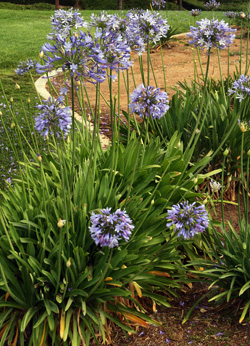Common Agapanthus Troubles and Just How to Fix Them
Common Agapanthus Troubles and Just How to Fix Them
Blog Article
Understanding the Art of Agapanthus Care: Crucial Actions for Healthy Development and Dynamic Flowers
In the world of gardening, the growing of agapanthus stands as a gratifying venture for those who seek to nurture these sophisticated blooming plants. With their striking flowers and elegant vegetation, agapanthus has actually captured the interest of gardeners worldwide. Nonetheless, achieving ideal growth and vivid blossoms requires a nuanced approach that includes various crucial actions. From choosing the right variety to grasping pruning strategies, the journey in the direction of growing prospering agapanthus plants is diverse and holds the vital to unlocking the full possibility of these herb treasures.

Choosing the Right Agapanthus Range

When picking the ideal Agapanthus range for your yard, take into consideration elements such as climate viability, bloom shade, and growth routine. Furthermore, take into consideration the climate in your area to ensure the Agapanthus variety you pick can flourish in your details problems. Comprehending the growth behavior of different Agapanthus ranges is crucial for appropriate positioning within your garden.
Perfect Growing Conditions
Taking into consideration the optimum environmental demands is essential for successful Agapanthus cultivation. Agapanthus grows in well-draining dirt with a somewhat acidic to neutral pH level. When growing, choose a location that obtains full sunlight to partial shade. In hotter climates, providing some mid-day shade can prevent scorching of the fallen leaves. Agapanthus plants are delicate to cold temperature levels and ought to be shielded from frost during winter season months.
To make sure healthy and balanced development and dynamic blossoms, plant Agapanthus light bulbs at a depth of concerning 2-4 inches and space them 8-12 inches apart. Including natural issue, such as garden compost, to the dirt can boost drainage and fertility, advertising robust root growth. Mulching around the base of the plants assists keep moisture and subdues weed growth. Regular watering is critical, specifically throughout the expanding season, to keep the soil consistently moist however not saturated.
Watering and Feeding Tips
Keeping appropriate dampness levels and offering important nutrients are crucial components in the care regimen for Agapanthus plants. When it comes to watering Agapanthus, it is essential to strike an equilibrium. If overwatered, these plants favor constantly wet soil yet are at risk to root rot. During the growing period, water deeply when a week, making sure the soil is well-draining to prevent waterlogging. In hotter climates or during durations of drought, more regular watering may be necessary to maintain the dirt uniformly damp. However, reduce watering in the winter to stop water logged problems.
Fertilizing Agapanthus is necessary for promoting healthy and balanced growth and respected flowers. Apply a well balanced plant food, such as a 10-10-10 formula, in the early springtime as brand-new development emerges. By following these watering and fertilizing pointers, you can guarantee your Agapanthus plants grow and produce lively, long-lasting blooms.
Trimming Techniques for Agapanthus
Trimming Agapanthus plants at the ideal times and with proper techniques is critical for maintaining their health and wellness and advertising optimal growth and flowering. The optimal time to prune Agapanthus remains in late wintertime or early springtime prior to brand-new development arises. Begin by eliminating any type of yellowing or dead leaves near the base of the plant. Cut them as short as possible without damaging the emerging shoots.
Deadheading spent blossoms can likewise reroute the plant's energy into producing more blossoms instead than setting seeds. If you desire to accumulate seeds for proliferation, leave some flowers to completely dry and mature on the plant.
Keep in mind to make use of clean, sharp tools to make exact cuts and reduce the threat of introducing illness. Agapanthus. Routine pruning will certainly help keep your Agapanthus looking neat and healthy more while ensuring a bountiful screen of stunning flowers
Dealing With Usual Parasites and Diseases
After making sure correct pruning methods for Agapanthus, it is vital to attend to common parasites and diseases that can impact the health and wellness and vigor of these plants. Agapanthus plants are usually durable yet can still come down with specific problems. One common parasite that influences Agapanthus is the Agapanthus gall midget. This small, orange fly lays its eggs in the foliage, leading to distorted growth and blossom buds that stop working to open. To combat this insect, prune and destroy any type of damaged plant parts and take into consideration utilizing insecticidal soap.
In addition, Agapanthus plants can experience from origin rot if they are planted page in improperly draining pipes dirt. By being watchful and taking punctual activity versus conditions and pests, you can aid your Agapanthus plants flourish and generate lively blossoms. Agapanthus.

Verdict
Finally, grasping the art of agapanthus treatment entails choosing the right selection, providing perfect planting conditions, proper watering and feeding, suitable trimming techniques, and dealing with common insects and illness. By complying with these necessary steps, you can make sure healthy development and lively flowers for your agapanthus plants. Keep in mind to consistently monitor and keep your plants to advertise their overall well-being and longevity.
To guarantee healthy growth and dynamic blooms, plant Agapanthus bulbs at a deepness of about 2-4 inches and area them 8-12 inches apart. By adhering to these watering and fertilizing suggestions, you can guarantee your Agapanthus plants thrive and generate vibrant, lasting blossoms.
One common insect that impacts Agapanthus is the Agapanthus gall midge. Furthermore, Agapanthus plants can suffer from root rot if they are grown in poorly draining pipes soil. By visit following these essential steps, you can make certain healthy and balanced development and dynamic flowers for your agapanthus plants.
Report this page